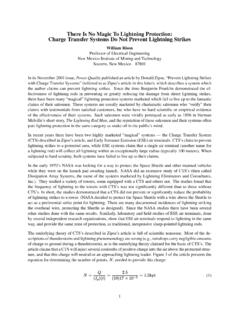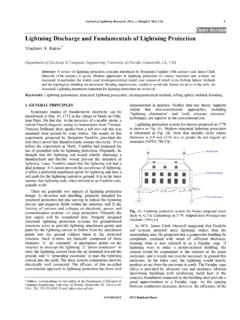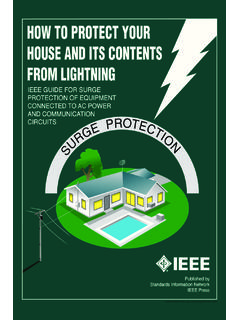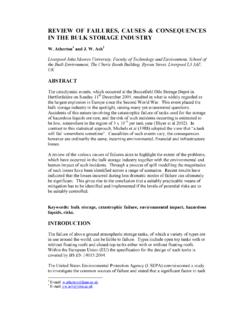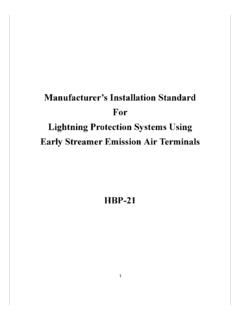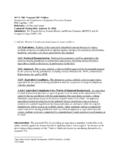Transcription of A review of studies on Early Streamer Emission and …
1 A review of studies on Early Streamer Emission and Charge transfer system conducted in malaysia . Z. A. Hartono, I. Robiah lightning Research Pte. Ltd., Kuala Lumpur, malaysia . E-mail: Abstract studies that compared the performances of the Early Streamer Emission (ESE) air terminals and the charge transfer system (CTS) with that of the Franklin rod (FR) system have been conducted in malaysia since 2003. The results from these studies suggest that the ESE and CTS systems were more effective than the FR system .
2 However, a review of the available information shows that the results were based on bizarre and flawed analyses of research data and that they were carried out by proponents of the ESE and CTS systems. I. INTRODUCTION The modern non-conventional lightning protection (LP) systems have been in the global market for over thirty years. They are classified into two main groups: (1) the lightning attracting air terminals such as the radioactive and ESE devices and (2) the lightning strike prevention air terminals such as the CTS and similar devices.
3 In the South East Asian region, the earliest non-conventional LP systems to be used were the radioactive air terminals in the 1970s. A field study on the performance of these devices in Singapore by Darveniza et al [1] showed that buildings that used them had been struck by lightning . They were replaced by the ESE air terminals when radioactive materials were banned from consumer products for safety reasons in the late 1980s. A field study conducted on the ESE devices by Hartono and Robiah [2] in Kuala Lumpur also showed similar results.
4 Hartono and Robiah also provided before and after event photographs that showed lightning strike damages well within the ESE claimed zone of protection. In a seven year long investigation using ESE and FR terminals of various tip geometries, Moore et al [3] showed that blunt tipped FR were repeatedly struck by lightning while nearby sharp tipped FR and ESE air terminals were never struck. The blunt tipped FR has been included in the NFPA 780 standard since 2002. Proposed standards for the ESE systems (eg.)
5 Draft NFPA781) have been rejected by CIGRE, IEC and the NFPA [4] in 1995. An independent review [5] of the ESE technology by the NFPA in 1999 again found it to be without scientific basis and was unproven. In France, the ESE vendors published a document, known as the NFC 17-102, which provided the guidelines for the manufacture, test and installation of the ESE devices. This document, which has been popularized as a French standard by the vendors, has been criticized by INERIS [6], a French scientific agency, for failing to conduct tests on the ESE air terminals.
6 The document also did not comply with either the IEC or CENELEC lightning protection standards which are already being used in France and throughout the European Union. A proprietary Australian method of ESE air terminal placement, known as the field intensification method (FIM), was also rejected by Standards Australia in 2003. The FIM is similar to the collection volume method (CVM) which is being used to install a proprietary Australian ESE air terminal globally. With the apparent popularity of the non-conventional LP system in the region, the CTS devices were introduced in the Early 1990s.
7 A field study [7] on the performance of the dissipation array system (DAS), another name for the CTS, showed that the system failed to prevent lightning strikes. This failure was also mentioned in a book [8] that is still being used as a reference by lightning protection engineers worldwide. Since then, there have been several studies that show that the DAS/CTS are incapable of preventing lightning strikes to the protected structures or areas. A draft lightning protection standard for the CTS was rejected five times by the NFPA between 1989 and 2004 due to insufficient scientific basis.
8 A similar draft standard, known as the PAR1576, was also proposed to the IEEE in 2000 but was rejected in 2004 due to similar reasons. To better understand the scientific issues involved, readers are recommended to read a critical review of the ESE and CTS that was written by Uman and Rakov [9][10]. II. THE ESE STUDY The summaries of these studies can be found on the electrical engineering website ( ) of Universiti Teknologi malaysia (UTM). To view the related summaries, click on the high voltage research link IVAT under the Research column, and then click on Research link while on the IVAT webpage.
9 Thereafter, click on the links that referred to the ESE studies . Copies of these web pages are also available on request. The extracts from the summaries are given below: A. Laboratory and field study of ESE system In this study [11] by Darus and Ngu, the following claims were made: x ESE is a relatively new approach in solving the perennial problem of lightning damage. x lightning damage has been associated with the use of FR. x ESE is believed to be providing more effective protection against lightning than a FR system . 17th International Zurich Symposium on Electromagnetic Compatibility, 200612817th International Zurich Symposium on Electromagnetic Compatibility, 2006x Slightly rounded air terminal, which is typical of ESE system offer better interception ability than that of sharp terminals, which is the typical FR design.
10 X Results have been obtained from field monitoring of real FR and ESE system installed in the university campus. x It is also shown that ionizing the air around the tip of the terminals can enhance its effectiveness. x ESE system has been found to intercept more lightning strikes than that by the FR. review : The claim that the ESE is a new approach is misleading since it had been used in malaysia for more than a decade and that the technology had been disproved in several published studies conducted within and outside the country.
